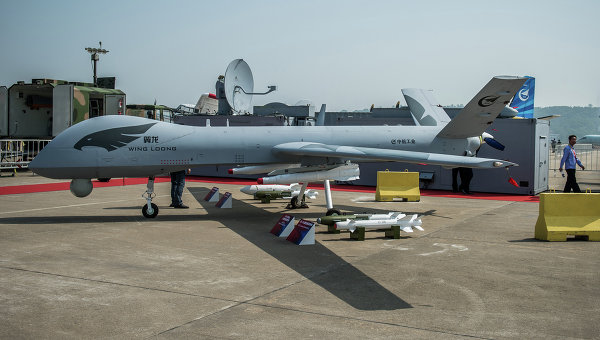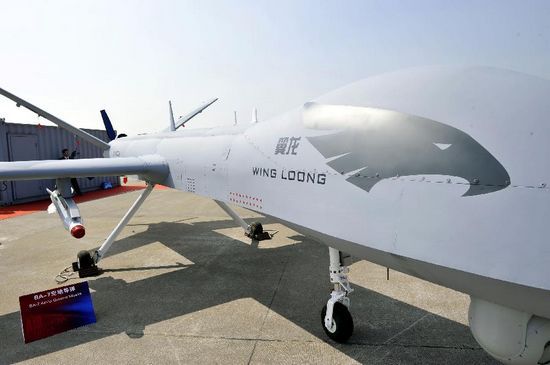مصدر يشير ان مصر والامارت ونيجيريا من زبائن الصين للطائرة Wing loong

وتوردها الصين بمبلغ مليون دولار للطائرة الواحدة
China’s Defense Industry Growing, but Still Not a Threat to the West
Chinese HQ-9 missile launcher during China’s 60th anniversary parade, Beijing, China, Oct. 1, 2009 (photo by Wikimedia user Jian Kang licensed under the Creative Commons Attribution 3.0 Unported license).
By The Editors, April 13, 2015, Global Insider
Earlier this month, Pakistan approved a deal to buy eight Chinese submarines, in what would be China’s largest-ever arms deal. In an email interview, Joseph E. Lin, a doctoral candidate in political science at the University of Pennsylvania, discussed China’s defense exports.
WPR: What are China’s main defense exports, and who are the biggest buyers of Chinese defense equipment?
Joseph E. Lin: In the past, China’s primary defense exports were a combination of small arms and light armored vehicles, sold mostly to countries in Africa or the Middle East. In recent years, however, there has been a qualitative shift in the nature of the platforms sold. China has begun exporting far more technologically advanced weapons, including unmanned aerial vehicles (UAV), air defense systems and light warships.
According to the Stockholm International Peace Research Institute, from 2010-2014, the top three importers of China’s weapons were Pakistan, Bangladesh and Myanmar. Of these, Pakistan was the largest, accounting for 41 percent of all Chinese defense exports during this period. The two countries have had long-standing defense ties, and Pakistan will remain one of the largest importers of Chinese weapons for the foreseeable future, especially given the recently announced deal to buy eight attack submarines. Although details of this deal have yet to be revealed, it is estimated by many experts to be worth $4 billion to $5 billion, making it one of the largest foreign sales in China’s history.
China has also begun expanding beyond its traditional clientele. In September 2013, for instance, Turkey selected China’s HQ-9 air defense system over U.S., Russian and Italian-French offerings. The exact figures of the deal—yet to be finalized and under heavy lobbying pressure from Turkey’s NATO allies, who oppose the purchase—were also not announced, though it is believed to be worth $3.4 billion.
WPR: What is behind China’s recent increase in defense sales?
Lin: There are two main factors behind the recent increase in China’s defense exports. First, a concerted strategy over the past two decades to develop and reform China’s defense industrial base has begun paying dividends in recent years. State-owned defense corporations that were long-plagued by systemic research, development and manufacturing deficiencies are now producing modern weapons systems that, while not cutting-edge, are reliable and cost-effective solutions. These examples include the F-22P frigate and the Wing Loong UAV, which China has sold to several countries in Africa and the Middle East, including Nigeria, Egypt and the United Arab Emirates. At roughly $1 million per unit, the Wing Loong offers capabilities that are similar to those of the U.S. Predator drone, which costs four times as much.
Second, many developing countries are seeking to upgrade their existing capabilities but are constrained by their limited defense budgets. They are therefore looking for weapons platforms that are affordably priced and “good enough”; China’s offerings satisfy both requirements.
WPR: What impact do Chinese defense exports have on the global defense market?
Lin: At the moment, China’s defense exports have only a marginal effect on the high-end segment of the global defense market, as most of its indigenously developed weapons systems are still inferior to their Western and Russian equivalents. Where it is likely to disrupt the global arms market is in the mid-tier segment, where it can provide cost-effective solutions for countries that do not need the most sophisticated weapons available. In the coming years, however, it would not be surprising to see Chinese weapons systems in direct competition with Western and Russian ones, especially in key areas like long-range precision strike systems, such as ballistic and cruise missiles.
http://webcache.googleusercontent.com/search…

وتوردها الصين بمبلغ مليون دولار للطائرة الواحدة
China’s Defense Industry Growing, but Still Not a Threat to the West
Chinese HQ-9 missile launcher during China’s 60th anniversary parade, Beijing, China, Oct. 1, 2009 (photo by Wikimedia user Jian Kang licensed under the Creative Commons Attribution 3.0 Unported license).
By The Editors, April 13, 2015, Global Insider
Earlier this month, Pakistan approved a deal to buy eight Chinese submarines, in what would be China’s largest-ever arms deal. In an email interview, Joseph E. Lin, a doctoral candidate in political science at the University of Pennsylvania, discussed China’s defense exports.
WPR: What are China’s main defense exports, and who are the biggest buyers of Chinese defense equipment?
Joseph E. Lin: In the past, China’s primary defense exports were a combination of small arms and light armored vehicles, sold mostly to countries in Africa or the Middle East. In recent years, however, there has been a qualitative shift in the nature of the platforms sold. China has begun exporting far more technologically advanced weapons, including unmanned aerial vehicles (UAV), air defense systems and light warships.
According to the Stockholm International Peace Research Institute, from 2010-2014, the top three importers of China’s weapons were Pakistan, Bangladesh and Myanmar. Of these, Pakistan was the largest, accounting for 41 percent of all Chinese defense exports during this period. The two countries have had long-standing defense ties, and Pakistan will remain one of the largest importers of Chinese weapons for the foreseeable future, especially given the recently announced deal to buy eight attack submarines. Although details of this deal have yet to be revealed, it is estimated by many experts to be worth $4 billion to $5 billion, making it one of the largest foreign sales in China’s history.
China has also begun expanding beyond its traditional clientele. In September 2013, for instance, Turkey selected China’s HQ-9 air defense system over U.S., Russian and Italian-French offerings. The exact figures of the deal—yet to be finalized and under heavy lobbying pressure from Turkey’s NATO allies, who oppose the purchase—were also not announced, though it is believed to be worth $3.4 billion.
WPR: What is behind China’s recent increase in defense sales?
Lin: There are two main factors behind the recent increase in China’s defense exports. First, a concerted strategy over the past two decades to develop and reform China’s defense industrial base has begun paying dividends in recent years. State-owned defense corporations that were long-plagued by systemic research, development and manufacturing deficiencies are now producing modern weapons systems that, while not cutting-edge, are reliable and cost-effective solutions. These examples include the F-22P frigate and the Wing Loong UAV, which China has sold to several countries in Africa and the Middle East, including Nigeria, Egypt and the United Arab Emirates. At roughly $1 million per unit, the Wing Loong offers capabilities that are similar to those of the U.S. Predator drone, which costs four times as much.
Second, many developing countries are seeking to upgrade their existing capabilities but are constrained by their limited defense budgets. They are therefore looking for weapons platforms that are affordably priced and “good enough”; China’s offerings satisfy both requirements.
WPR: What impact do Chinese defense exports have on the global defense market?
Lin: At the moment, China’s defense exports have only a marginal effect on the high-end segment of the global defense market, as most of its indigenously developed weapons systems are still inferior to their Western and Russian equivalents. Where it is likely to disrupt the global arms market is in the mid-tier segment, where it can provide cost-effective solutions for countries that do not need the most sophisticated weapons available. In the coming years, however, it would not be surprising to see Chinese weapons systems in direct competition with Western and Russian ones, especially in key areas like long-range precision strike systems, such as ballistic and cruise missiles.
http://webcache.googleusercontent.com/search…





